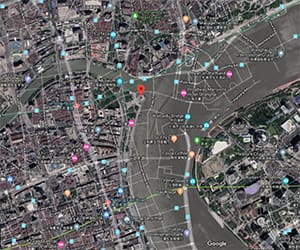The Global Positioning System (GPS) has become embedded in just about every electronic device imaginable. Even less widely used systems like Russian GLONASS or the still-developing European Galileo and Chinese BeiDou satellite navigation systems are showing up in navigational devices and embedded chipsets. Taken together, these satellite positioning systems are called Global Navigation Satellite Systems (GNSS). For them to work effectively, they must have an accurate model of the shape of the Earth. All these systems make use of a model of the Earth called World Geodetic System 84 (WGS 84). Interestingly, however, the Chinese BeiDou system puts its own somewhat-paranoid spin on WGS 84 for positions in China.
WGS 84 is a mathematical model for describing the shape of the Earth. It takes into account the fact that the Earth is not a perfect sphere. The technical name for Earth’s true shape is “oblate spheroid.” That means the globe is flatter at the poles and chunkier at the equator than a true sphere. And that is merely the overall shape; there also localized bumps and depressions. Taking note of these departures from perfection is not nitpicking or globe-shaming on the part of geodecists and chart makers. These imperfections are important in making the model of the shape of the Earth as accurate as possible. This model is called a datum, and GNSS needs a solid datum to ensure the accuracy of satellite navigation position fixes. WGS 84 is the current datum used by GPS, GLONASS and Galileo. The Chinese BeiDou system, which currently only provides full coverage in East Asia but is expected to be expanded globally, has its own datum for use in China. This datum is called GCJ-02. Sometimes referred to as Mars Coordinates, the GCJ-02 datum — which is based on WGS 84 — was developed by the Chinese State Bureau of Surveying and Mapping. The datum makes use of an “obfuscation algorithm” to purposely induce error by the introduction of random offsets to latitude and longitude, making the position solution less accurate. According to the Chinese, this is done to enhance Chinese national security.
This dilution of accuracy is similar to the U.S. Defense Department’s early use of a technique called selective availability (SA) to deny the full accuracy of GPS to non-U.S. military users. Due to the U.S. government and the business community’s desire to widen the acceptance of GPS, SA was later dropped and all users were given access to full GPS accuracy.
Right now, BeiDou is a regional system that provides its best satellite geometry over China and East Asia. As it is expanded with more satellites and transitions to full worldwide coverage, it will be interesting to see if Chinese authorities drop the GCJ-02 scheme and provide users, which could include voyagers in Chinese coastal waters using BeiDou receivers, with the system’s full capability. Since BeiDou was developed 20 years later than GPS and Chinese engineers had the opportunity to study the GPS and Galileo systems and make improvements, the BeiDou system is reportedly capable of greater levels of accuracy than those older systems.

